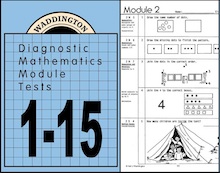
Struggling students generally have a poor grasp of basic concepts, Tests 1-15 cover a w...
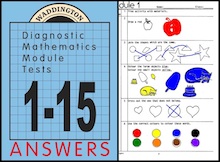
For preschool, junior primary and remedial secondary. Now with coloured answers for eve...
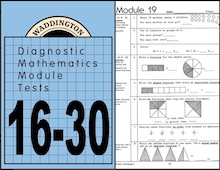
For primary and lower secondary students (approx ages 9 - 13). Answer book sold separat...
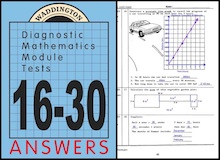
For primary and lower secondary students. Now with coloured answers for even quicker ma...
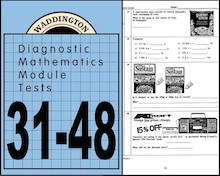
For secondary students (approx ages 13-16) or for gifted/talented programs. Book 31-48 ...
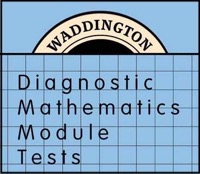
The Waddington Diagnostic Mathematics Module Tests are primarily criterion-referenced based, as opposed to norm-referenced, for diagnosing student strengths and weaknesses and focus on essential/important skills. They are inclusive of the essential skills, in the right order and at the right lateral and cross-ways strand positions, for efficient diagnosis and remediation of students struggling with math concepts. The Waddington Diagnostic Mathematics Module Tests provide clear information about student acquisition of building block skills, as well as more complex skills with the use of everyday examples and heavy use of picture/product clues. The tests are of particular value in identifying students with deficits within their mathematical learning whilst assisting them to understand new concepts. The tests look at children as individuals, so also cater for more capable students who need to power ahead.
There is no strict time limit for each test, however, there is a set range of tests for particular age/year levels. The tests can be used on a group or one-to-one basis.
The Waddington tests will provide important evidence of student achievement outside of any particular curriculum.
It is recommended that all students, regardless of age, will need checking with Tests 1-15 before progressing to tests beyond 16. Even teenagers with a history of poor performance should be put through the lower tests to check they have essential foundation skills in place. It is important that all students function at or below their independent competency range to ensure skills are absorbed properly to minimise the prospect of higher order skills becoming too challenging or impossible to understand.
APPROXIMATE GRADE / AGE / TEST GUIDE For example, all Year 2 students could be given Test 5 at the start of a school year, Year 3 students would be given Test 8 at the start of their school year and so on. However, where older students have not gained any solid foundation, then start them off at Test 5 or even Test 1. GRADE AGE TESTS MAX. RAW SCORE Rec/Pre 5 1 - 3 73 Year 1 6 4 - 6 56 Year 2 7 7 - 9 54 Year 3 8 10-13 72 Year 4 9 14-17 80 Year 5 10 18-21 83 Year 6 11 22-25 69 Year 7 12 26-29 74 Year 8 13 30-33 113 Year 9 14 34-38 139 Year 10 15 39-43 152 Year 11 16 44-48 147
Given these tests can be efficiently used on a group or one-to-one basis, they quickly highlight student strengths and weaknesses. If used on a cross-school basis, student results can be recorded and compared year to year using the Maths subject section of the School Data Express (free with any ebook purchase). School Data Express allows for the automated graphing of student Math percentage results over time. Student results can be compared against the average results of any found group (or all records) in your school.
The maximum raw score is based on the total number of question sections. It is up to individual teachers to decide how they score the tests. It is also important for teachers to make informed judgements about a student's understanding of particular concepts as well as their degree of applied skill. This may not always be apparent on face value and may necessitate the teacher running brief student conferencing or allowing students time to revisit test items (particularly if they have overlooked items or failed to comprehend the direct meaning of a task in the first instant). It is recommended that a mark be given for a question section where more than half of the examples are answered correctly and/or demonstrate understanding by the student. Therefore, question section 1 has 15 response examples. If the student answers 8 correctly, the teacher may give half a mark for question section 1. If the student answers 13 correctly, the teacher may give a full mark for that section. Once all the marks are added up, a student may score 17 out of 19 for Test 16. This approximate 90% success rate quickly demonstrates the time is right for the student to move on to harder skill learning phases and/or the next test. A score of less than 17 means failed test sections would need to be revisited with appropriate learning opportunities. Unlike norm-referenced tests, students should be given their marked tests back so they can see evidence of their successes and failures. Students should not move on to a higher test until current test concepts are consolidated to a high proficiency rate. This is important because higher order concepts introduced in later tests are dependent on prior test concepts.
Complex concepts are supported by lower order concepts in earlier tests. For example, children who have trouble telling the time need to understand foundation concepts such as recognising numerals, understanding quantity and order, counting by ones, fives and tens, event sequencing, even understanding exactly what half and quarter actually mean. All these essential foundation skills are covered before clock-face time is introduced.
The Waddington Diagnostic Mathematics Module Tests provide clear information about student acquisition of building block skills, as well as more complex skills with the use of everyday examples and heavy use of picture/product clues. The tests are of particular value in identifying students with deficits within their mathematical learning whilst assisting them to understand new concepts in a logical and well ordered fashion.

